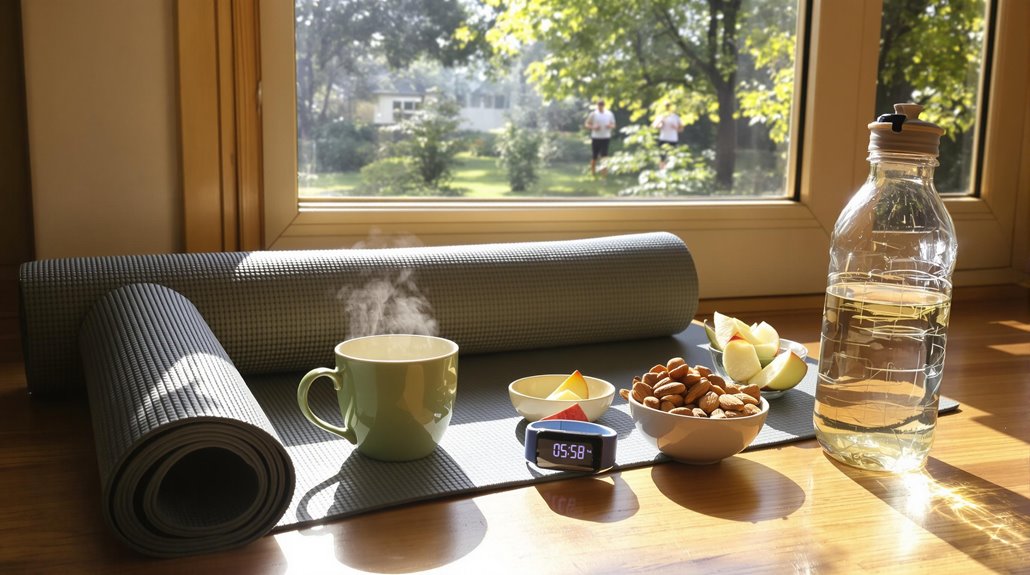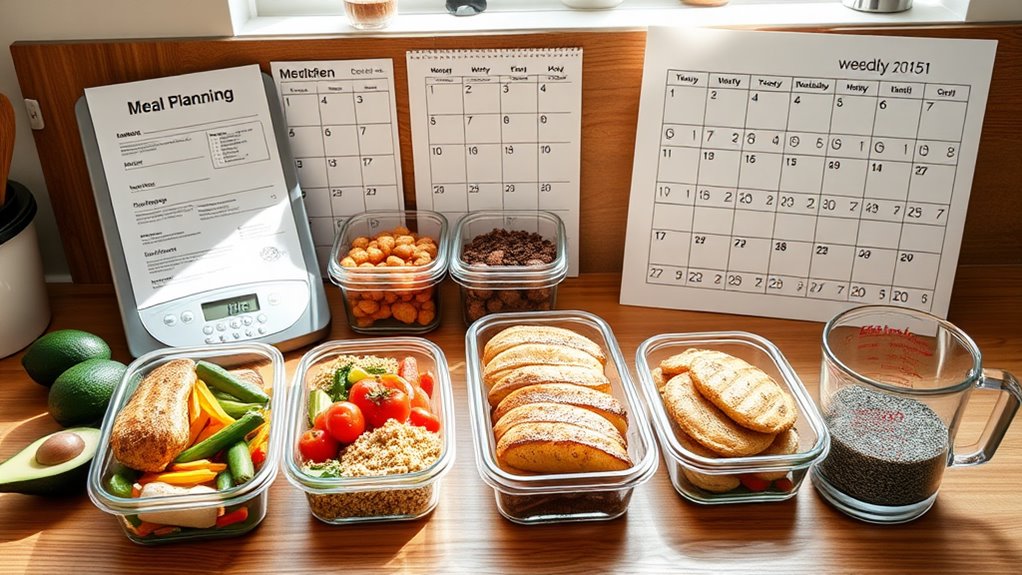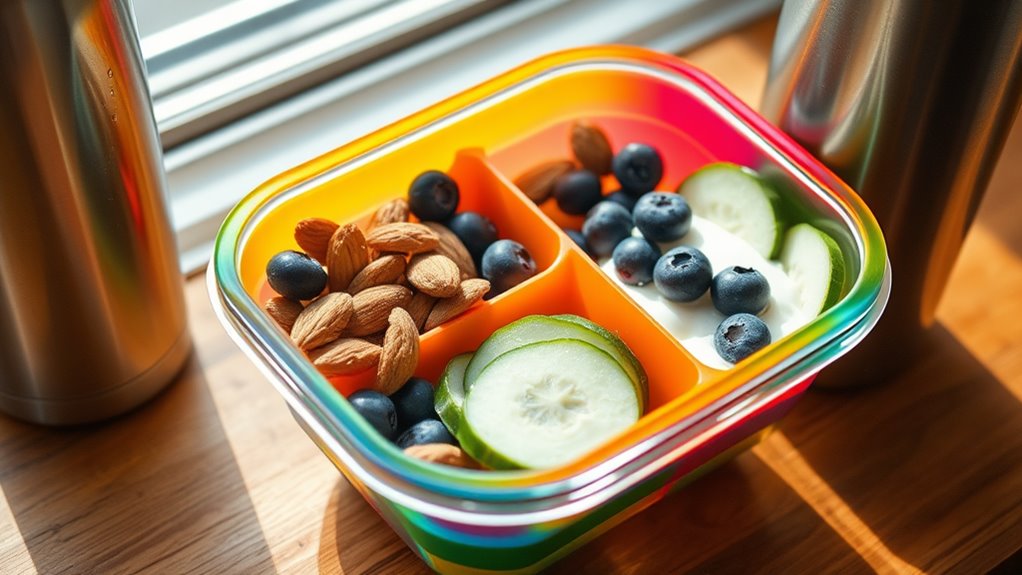Discover the science-backed morning routines and lifestyle tweaks that melt stubborn belly fat and transform your midsection without strict dieting.

You'll accelerate belly fat loss through strategic daily habits that target your metabolism and fat-burning potential. Start by drinking 16 ounces of warm water within 30 minutes of waking, followed by morning exercise before breakfast to burn up to 20% more body fat. Combine this with protein-rich meals, stress management, and consistent sleep patterns. Focus on both NEAT activities and structured workouts throughout your day. These science-backed approaches form the foundation for sustainable midsection changes.
Ever wondered why morning habits play such an essential role in reducing belly fat? The first hours after waking up present a prime opportunity to optimize your body's fat-burning potential through strategic choices and activities.
Start your day by drinking 16 ounces of warm water within 30 minutes of waking up to jumpstart your metabolism. You'll enhance these benefits by adding lemon, cinnamon, chia seeds, or apple cider vinegar. For maximum fat-burning results, exercise before breakfast – you'll burn up to 20% more body fat compared to later workouts. Aim for 30 minutes of moderate activity, whether it's a brisk walk, HIIT session, or strength training. Taking a few minutes to practice stress-reducing meditation can help prevent cortisol-related fat storage.
Follow your workout with a high-protein breakfast paired with fiber-rich foods, avoiding sugary drinks and refined carbs. Choose eggs, Greek yogurt, or cottage cheese, and complement your meal with green tea or black coffee to maintain steady energy levels and support fat oxidation.

Building on the foundation of effective morning habits, smart meal planning serves as a powerful tool for reducing abdominal fat. You'll want to structure your meals around whole, nutrient-dense foods while maintaining careful portion control throughout the day.
Start by prioritizing protein-rich breakfasts to kickstart your metabolism, then incorporate complex carbohydrates and healthy fats into balanced meals. Choose fiber-rich foods like legumes, whole grains, and fresh vegetables to promote satiety and improve digestion. You'll find that eating smaller, more frequent meals helps prevent overeating and stabilizes blood sugar levels. Following a structured meal plan can help you maintain consistency and achieve better results.
Pay attention to your hydration needs by drinking water throughout the day, and limit sodium intake to prevent bloating. When preparing meals, opt for healthy cooking methods like steaming or roasting, and keep processed foods to a minimum. Remember to practice mindful eating by chewing slowly and listening to your body's hunger signals.
When it comes to burning stubborn belly fat, high-intensity exercises paired with strategic interval training deliver the most efficient results. Sprint Interval Training (SIT) stands out as particularly effective, showing nearly 40% greater reduction in body fat percentage compared to traditional HIIT workouts, while requiring 61% less time commitment.
You'll maximize your fat-burning potential by incorporating exercises like burpees, kettlebell swings, and box jumps into your routine. These movements engage multiple muscle groups simultaneously and keep your heart rate elevated. For ideal results, combine these with full-body workouts such as kettlebell circuits, which burn up to 822 calories per hour, and loaded carries that build strength while torching fat. Incorporating sled push variations into your routine allows for frequent training sessions due to minimal muscle damage.
Remember to vary your routine between different high-intensity exercises. This approach not only prevents plateau but also maintains metabolic efficiency, as your body continues to burn calories hours after completing your workout.

Strategic snacking can make or break your belly fat loss goals, with research showing that well-timed, nutrient-dense choices considerably impact fat storage and metabolism. To enhance your results, prioritize protein-rich options like Greek yogurt with berries or hard-boiled eggs, which help preserve muscle mass while promoting satiety. Hummus made with chickpeas delivers plant-based protein and works perfectly with colorful veggie sticks for a balanced snack option.
Combine your protein choices with fiber-rich foods and healthy fats to create balanced snacks that sustain energy levels and prevent blood sugar spikes. You'll find success by incorporating these proven options throughout your day:
Remember to maintain regular snacking intervals and stay hydrated to prevent overeating and support effective digestion during your belly fat loss journey.
Your evening habits play an essential role in managing belly fat, as research shows that nighttime behaviors directly impact hormonal balance and fat storage patterns. To enhance your body's fat-burning potential, eat your last meal 3-4 hours before bedtime, as consuming food when melatonin levels rise can increase body fat storage. Consider drinking water between meals to help curb late-night hunger impulses and promote better digestion.
Create a calming pre-sleep routine that supports weight management. Turn off screens at least an hour before bed, as late-night TV viewing and email checking can trigger mindless eating and stress-related weight gain. Instead, engage in relaxation techniques like gentle stretching, meditation, or reading. These activities reduce stress hormones that contribute to belly fat accumulation.
Set up your bedroom environment for ideal sleep by keeping it dark, quiet, and cool. Maintain consistent sleep and wake times, and avoid caffeine, heavy meals, and intense exercise close to bedtime. These adjustments will help regulate your appetite hormones and support healthy weight management.

Chronic stress directly contributes to stubborn belly fat through elevated cortisol levels, making stress management a significant factor in weight loss success. You can combat this by incorporating evidence-based stress-reducing activities into your daily routine. Start with mindfulness practices, deep breathing exercises, or meditation sessions to lower your cortisol levels naturally. Visceral fat accumulation poses serious health risks, particularly around vital organs in your abdomen.
Physical activity plays an essential role in stress management and belly fat reduction. Aim for 30 minutes of moderate-intensity exercise four days weekly, combining both aerobic activities and strength training for ideal results.
Track your progress using fitness devices and regularly reflect on your stress management strategies, adjusting them as needed for continued success.

Transforming daily movements into calorie-burning opportunities can greatly impact belly fat reduction through NEAT (Non-Exercise Activity Thermogenesis). You'll boost your daily calorie burn by implementing the 6/60 rule – standing or moving for 6 minutes every hour – and incorporating fidgeting, which can burn up to 350 calories daily.
Make your daily routine more dynamic by combining tasks with movement. Try walking while doing housework, incorporating high knees when moving between rooms, or varying your body posture throughout the day. Add structured exercise like HIIT, swimming, or jumping rope to amplify your results. These activities can burn 400-670 calories per hour, depending on intensity. High-intensity cycling on a stationary bike can significantly boost calorie burn while being gentle on your joints.
For ideal fat loss, combine cardio with strength training through circuit workouts. This approach not only burns calories during exercise but increases your resting metabolic rate by building lean muscle, making your body more efficient at burning fat throughout the day.
You'll find that medications like beta-blockers, certain antidepressants, corticosteroids, and some heart medications can increase belly fat by affecting metabolism, appetite, and fat distribution in your body.
Yes, alcohol impacts fat storage patterns, particularly in your abdominal area. When you drink alcohol, it suppresses fat metabolism and can lead to increased visceral fat around your organs.
Like a shifting landscape, your body's declining estrogen during menopause redirects fat storage from your hips to your belly, increasing visceral fat around organs and changing your shape from pear to apple.
Yes, your chronic health conditions can make belly fat harder to lose due to increased inflammation, insulin resistance, and metabolic changes that promote fat storage and slow down fat-burning processes.
If you've noticed your fat pattern matches your parents', that's no coincidence. Genetics strongly influence fat distribution, with studies showing up to 60% of waist-to-hip ratio variations are inherited.
You're now equipped with powerful daily habits that can transform your waistline. Picture yourself waking up to a flatter stomach, energized by science-backed routines that melt away stubborn belly fat. By integrating these evidence-based strategies – from strategic meal timing to stress-reducing activities – you've got an extensive toolkit for sustainable fat loss. Remember, consistency in these small daily actions creates significant metabolic changes over time.